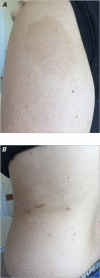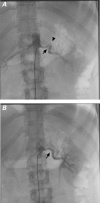Revascularization in a 17-Year-Old Girl with Neurofibromatosis and Severe Hypertension Caused by Renal Artery Stenosis
- PMID: 28265213
- PMCID: PMC5317360
- DOI: 10.14503/THIJ-15-5466
Revascularization in a 17-Year-Old Girl with Neurofibromatosis and Severe Hypertension Caused by Renal Artery Stenosis
Abstract
Renal artery stenosis caused by neurofibromatosis is a rare cause of renovascular hypertension. This hypertension can develop during childhood and is one of the leading causes of poor outcome. We report the case of a 17-year-old girl who was incidentally diagnosed with severe hypertension. During her examination for secondary hypertension, we reached a diagnosis of neurofibromatosis type 1 on the basis of a cluster of typical findings: optic nerve glioma, café au lait spots, nodular neurofibromas, and axillary freckling. Renal angiograms revealed a hemodynamically significant left renal artery stenosis (70%). Renal angioplasty with a self-expanding stent was performed one month later for rapidly progressive renal artery stenosis (90%) and uncontrolled blood pressure. Excellent blood pressure control resulted immediately and was maintained as of the 2-year follow-up evaluation. We think that percutaneous transluminal renal angioplasty can be effective in select patients who have neurofibromatosis type 1 and refractory hypertension caused by renal artery stenosis.
Keywords: Blood pressure monitoring, ambulatory/methods; hypertension, renovascular/diagnosis/etiology/radiography/therapy; neurofibromatosis 1/complications/metabolism/pathology; renal artery obstruction/complications/pathology/therapy; treatment outcome; vascular diseases/physiopathology.
Figures




Similar articles
-
Sirolimus-eluting stent placement for refractory renal artery in-stent restenosis: sustained patency and clinical benefit at 24 months.Vasc Med. 2009 Nov;14(4):361-4. doi: 10.1177/1358863X08102001. Vasc Med. 2009. PMID: 19808721
-
Treatment of neurofibromatosis associated renal artery stenosis with hypertension by percutaneous transluminal angioplasty.Clin Exp Hypertens A. 1986;8(4-5):893-9. doi: 10.3109/10641968609046609. Clin Exp Hypertens A. 1986. PMID: 2944678
-
Novel technique for treatment of a renal artery occlusion in a child with neurofibromatosis: a combined endovascular and laparoscopic approach.Vasc Endovascular Surg. 2009 Apr-May;43(2):199-206. doi: 10.1177/1538574408326263. Epub 2008 Nov 7. Vasc Endovascular Surg. 2009. PMID: 18996914
-
Management of Renovascular Hypertension.Tech Vasc Interv Radiol. 2016 Sep;19(3):211-7. doi: 10.1053/j.tvir.2016.06.006. Epub 2016 Jun 3. Tech Vasc Interv Radiol. 2016. PMID: 27641455 Review.
-
Endovascular Management of Neurofibromatosis Type I-Associated Vasculopathy: A Case Series and Brief Review of the Literature.Vasc Endovascular Surg. 2020 Feb;54(2):182-190. doi: 10.1177/1538574419885257. Epub 2019 Oct 31. Vasc Endovascular Surg. 2020. PMID: 31672102 Review.
Cited by
-
Beyond Atherosclerosis and Fibromuscular Dysplasia: Rare Causes of Renovascular Hypertension.Hypertension. 2021 Sep;78(4):898-911. doi: 10.1161/HYPERTENSIONAHA.121.17004. Epub 2021 Aug 30. Hypertension. 2021. PMID: 34455817 Free PMC article. Review.
References
-
- Hamilton SJ, Friedman JM. . Insights into the pathogenesis of neurofibromatosis 1 vasculopathy. Clin Genet 2000; 58( 5): 341– 4. - PubMed
-
- Tedesco MA, Di Salvo G, Ratti G, Natale F, Calabrese E, Grassia C, . et al. Arterial distensibility and ambulatory blood pressure monitoring in young patients with neurofibromatosis type 1. Am J Hypertens 2001; 14( 6 Pt 1): 559– 66. - PubMed
-
- Oderich GS, Sullivan TM, Bower TC, Gloviczki P, Miller DV, Babovic-Vuksanovic D, . et al. Vascular abnormalities in patients with neurofibromatosis syndrome type I: clinical spectrum, management, and results. J Vasc Surg 2007; 46( 3): 475– 84. - PubMed
-
- Neurofibromatosis. Conference statement. National Institutes of Health Consensus Development Conference. Arch Neurol 1988; 45( 5): 575– 8. - PubMed
-
- Caps MT, Zierler RE, Polissar NL, Bergelin RO, Beach KW, Cantwell-Gab K, . et al. Risk of atrophy in kidneys with atherosclerotic renal artery stenosis. Kidney Int 1998; 53( 3): 735– 42. - PubMed
Publication types
MeSH terms
LinkOut - more resources
Full Text Sources
Other Literature Sources
Research Materials

